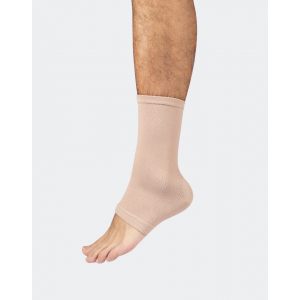Do I need an ankle brace?


Its compression and support can help you recover and prevent major injuries to the joint.
Before considering whether or not you need an ankle brace to prevent or treat your injury, it is essential that you understand the root of the problem. In this post, we will briefly review what our ankle is like, the most common injuries and if the ankle brace can be an effective solution in your case.
Ankle anatomy
The ankle joint is made up of three bones: the tibia, the fibula, and the talus. This allows for forward and backward movements of the foot. On the other hand, the bony appendages called the fibular malleolus and the tibial malleolus prevent a complete rotation of the foot.
The ligaments stabilize the ankle by preventing excessive movement:
- External lateral ligament: It is responsible for holding the ankle laterally.
- Deltoid ligament: This one, on the other hand, is responsible for supporting the inner side of the ankle.
- Syndesmal ligament: Joins and holds together the most distant parts of the tibia and fibula.
The muscles that make up the area are the following:
- Extrinsic muscles: They are located in the leg but thanks to them we can move the ankles and the foot.
- Intrinsic muscles: They are found in the foot and allow the toes to move.
- Plantar flexors: They are located at the back of the leg and are responsible for plantar flexion. We're talking about the soleus, the calves, and the Achilles tendon.
- Dorsal flexors: They are responsible for lifting the foot. They are located in the anterior part of the leg: the tibialis and the fibular anterior.
- Inverters of the foot: The protagonists are the tibialis posterior and the tibialis anterior, again.
- Eversors of the foot: The eversion is achieved thanks to the peroneus longus, the brevis and the third peroneus.
What ankle injuries are most common?
It is essential that before considering whether or not you should wear an ankle brace to prevent or treat your injury, you understand what the problem is:
- Sprain: It happens when we twist or bend the ankle in an unnatural way. Most sprains damage the external ligaments. There are different severities of the injury, however, the symptoms are usually pain when bearing weight on the damaged foot, swelling, bruising and instability. Talking to a doctor is the best way to evaluate the sprain.
- Achilles tendinitis: It is an injury that consists of overloading the Achilles tendon. It is very common in runners who suddenly extend their training durations. This injury manifests itself after playing sports, with pain in the back of the leg, just above the ankle. If it persists for a few weeks, it is best to see a doctor to confirm that you do not suffer from an Achilles tendon fracture.
- Tibialis Anterior Muscle Tendinitis: This is another injury that affects many runners and athletes due to the high load on the tibialis anterior. The muscle tendon becomes inflamed due to overuse or trauma. Pain is felt in the shin area, which requires rest to be relieved.
- Peroneal muscle tendinitis: When the peroneal tendons become inflamed, we speak of tendinitis. It is caused by excessive load and use, usually by athletes and runners. Pain at the back of the ankle is often aggravated during exercise.
When is it advisable to wear an ankle brace?
Ankle braces are garments that adjust to the joint with the aim of increasing stability and safety when walking or doing any other type of physical exercise. They provide compression, improve blood circulation and prevent the ankle from over-rotating.
They are ideal for recovering from sprains, especially grade I or grade II. In addition, the ankle brace is one of the best alternatives to prevent relapses when we play sports. They are also recommended to treat peroneal muscle tendinitis and Achilles tendinitis.
We advise you to talk to your doctor because his opinion is the most valid. Also, keep in mind that not all anklets are created equal. Below we explain the different solutions.
Types of ankle braces
- Sleeves: They are the most common and affordable on the market. They provide warmth and compression for minor sprains. They do not immobilize as much as other varieties of ankle brace but they are enough to protect the joint in most situations.
- Bandage anklet: It is a more discreet option, more suitable for situations where we do not want to show a larger garment. They have less support than sleeves but serve as a method of preventing sprains.
- Stabilizing ankle support: This garment, more voluminous, has velcros that are fastened to give more stability. They are recommended for people with chronic laxity.
How to put on the anklet?
Putting on the ankle brace correctly is something very simple but at the same time crucial for you to do its function. When it comes to a sleeve, open it like a sock and roll it up to the area of the injured ankle. Make sure that you cover the entire joint and that it fits you without tightening more than necessary. It is also not good that it is loose, so before making the purchase you will need to confirm that your ankle perimeter matches the range of the size you want to acquire.
References
- https://www.biolaster.com/traumatologia/tobillo/anatomia/
- https://www.mayoclinic.org/es-es/diseases-conditions/sprained-ankle/symptoms-causes/syc-20353225
- https://www.mayoclinic.org/es-es/diseases-conditions/sprained-ankle/symptoms-causes/syc-20353225
- https://www.mayoclinic.org/es-es/diseases-conditions/achilles-tendinitis/symptoms-causes/syc-20369020
- https://www.fisioterapia-online.com/tendinitis-del-tibial-anterior-que-es-causas-sintomas-diagnostico-tratamiento
- https://www.medicalnewstoday.com/articles/es/tendinitis-de-los-peroneos#sintomas



